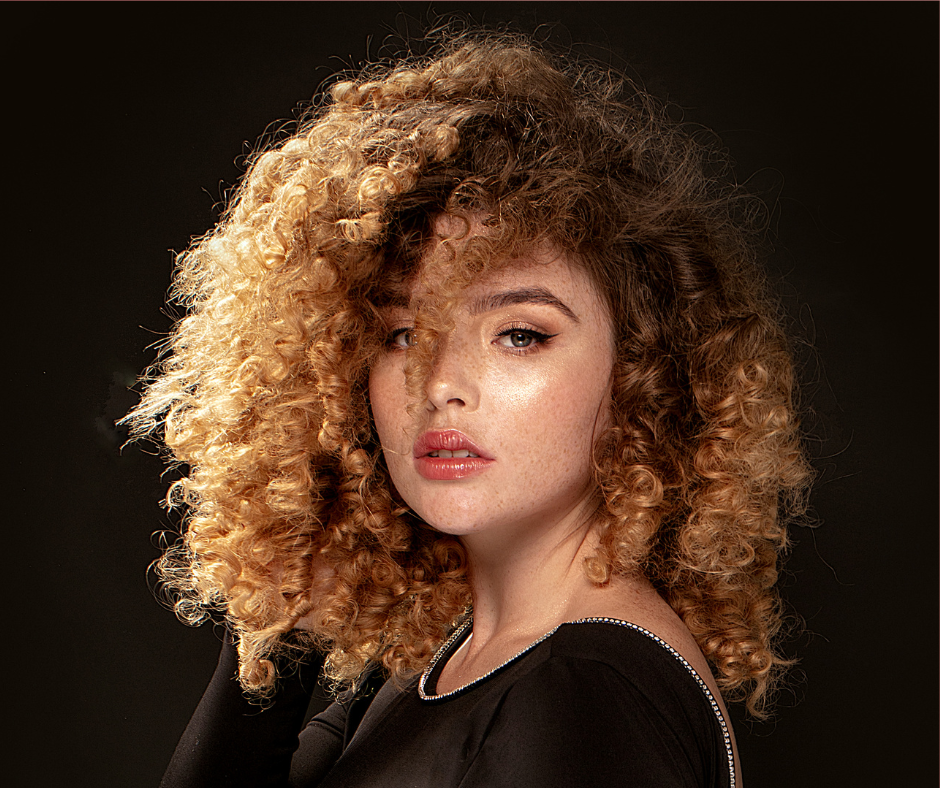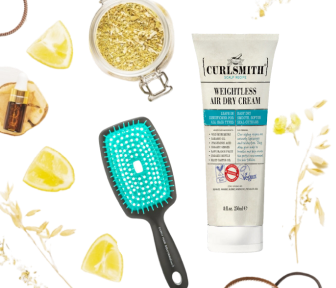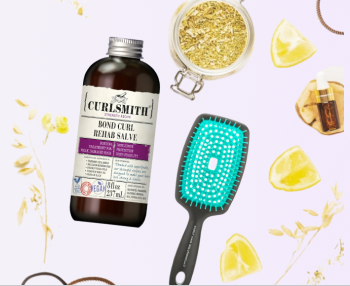Silicones and curly hair have been a hotly debated topic in the curly community, with warnings like, "Silicones are bad for your curls!" or "They’ll dry out your hair!" Silicones are a generally a no-go if you're strictly following the Curly Girl/Hair Method. But is that the full story? Not quite.
The truth is, that not all silicones are created equal. Some act like an overprotective friend, shielding your hair from harm, while others can be a little too clingy and refuse to leave without a deep cleanse.
Knowing which is which makes all the difference.
So, before you swear off silicones forever, let’s break it down.
What are Silicones?
Silicones are typically colourless oils or rubber-like substances.
How do they fit into hair care products?
Silicones are emollients, meaning they help soften, smooth, and add shine to the hair by forming a thin protective layer over the strands. They can seal in moisture and prevent curls from frizzing up in humidity, not to mention their excellent lubricating properties!
So, are all silicones bad for curly hair? The short answer is no—silicones are not bad in and of themselves.
Common Silicone Misconceptions
One of the biggest myths is that silicones are drying. While they do form a protective film over the hair to shield it from humidity, sunlight, and friction, they also lock in moisture. This can sometimes create a "drying effect," almost like making your strands feel waterproof. You might think that’s a bad thing, but it actually isn’t—healthy hair is hygroscopic, meaning it doesn’t like to absorb excess water anyway.
Another misconception is that silicones create an impenetrable film. That’s not entirely true either! Some silicones can be rinsed out with just plain water, while others might require much more effort than that.
That said, silicone buildup can weigh curls down, and their lubricating properties may leave some wavy or curly hair looking flat, limp, or lifeless—especially if your shampoo, leave-in conditioner, and styling products all contain silicones, making them more likely to build up and harder to remove.
Good Vs. Bad Silicones

The fear of silicones largely comes from generalizations. Silicones are a broad category on their own, and while absorbing all the details can feel overwhelming, running away from what might be a holy grail product out of fear could mean missing out on something great for your hair.
So, without further ado, let’s look at the categories of silicones—what’s good and what’s not so good.
Silicones that Evaporate
This group of silicones can be classified as pretty much harmless because they completely evaporate from your hair within 10 minutes to a few hours.
Think of them as delivery men—they drop off other beneficial ingredients at your hair’s "doorstep" and then leave. Any remaining residue from those ingredients can be easily washed out with your regular shampoo.
Evaporating Silicones List:
-
Cyclomethicone
-
Cyclomethiconal (Cyclomethiconel)
-
Cyclopentasiloxane
-
Hexamethyldisiloxane
-
Decamethylcyclotetrasiloxane
-
Hexamethylcyclotrisiloxane
-
Hexamethyldisiloxane
-
Octamethylcyclotetrasiloxane
Water Soluble Silicones
Silicones are typically classified into water-soluble and water-insoluble types. In this context, solubility refers to rinse-ability— these water-soluble silicones don’t just evaporate but provide benefits to the hair while still being easy to wash out with a mild moisturizing shampoo or co-washing or just water.
These silicones are safe to use, and there’s nothing to worry about!
But are water-soluble silicones really water-soluble?
They should be—but here’s the catch: Formulation matters. When ingredients are blended into a product, they interact with your hair, and buildup can happen—but that doesn’t mean the silicones are always to blame.
Want to test if a product containing silicones is water-soluble? Try this quick trick:
-
Smear a bit of the product on a smooth, clear glass.
-
Let it dry completely.
-
Rinse it off with plain water or gently rub it with your finger and water.
-
If it rinses off completely without leaving a greasy smear, it’s likely water-soluble.
Hair bonds with products more than glass does, so this isn’t 100% reliable—but it can at least get you started. You could also do a patch test on a section of hair and take note of how it feels afterwards.
Examples of Water-Soluble Silicones:
-
Diphenyl Dimethicone
-
Dimethicone
-
Dimethiconol
-
Disiloxane
-
Dimethicone Copolyol
-
Hydroxypropyl Polysiloxane
-
Lauryl Methicone Copolyol
-
Phenyltrimethicone
-
Silica
-
Silicone Resin
-
Silsequioxanes
-
Siloxysilicates (e.g., Diisostearoyl Trimethylolpropane Siloxysilicate)
-
Trisiloxane
-
Dimethicone copolyol
-
DEA PG-Propyl PEG/PPG-18/21 Dimethicone
-
Dimethicone PEG-8 Phosphate
-
Dimethicone-PG Diethylmonium Chloride
-
Hydrolyzed Silk PG-Propyl Methylsilanediol Crosspolymer
-
Hydrolyzed Wheat Protein Hydroxypropyl Polysiloxane
-
Hydrolyzed Wheat protein/hydroxypropyl polysiloxane and cystine/silicone co-polymers
-
Hydrolyzed Vegetable Protein PG-Silanetriol
-
Hydrolyzed Wheat Protein PG-Propyl Silanetriol
-
PEG-40/PPG-8 Methylaminopropyl/Hydroxypropyl Dimethicone Copolymer
-
PEG/PPG-14/4 Dimethicone
-
PEG/PPG-20/15 Dimethicone
-
PEG-12 Dimethicone
-
PEG/PPG-20/15 Dimethicone
-
PPG-8 Methylaminopropyl, Hydroxypropyl Dimethicone Copolymer
-
PEG-7 Amodimethicone
-
PEG-8 Disteramonium Chloride PG-Dimethicone
-
PEG-33 (and) PEG-8 Dimethicone (and) PEG-14
-
Silanetriol

Anywhere you see PEG or PPG in front of a silicone name, it most likely means the silicone is water-soluble. This is the easiest way to remember if a silicone is water-soluble without having to remember this list.
Water-soluble silicones are great for leave-in conditioners.
Here are a few examples:
Water-Insoluble Silicones
These silicones don’t wash out easily. However, both sulphate shampoos and some sulphate-free shampoos are still capable of removing water-insoluble silicones, especially if you are washing your hair thoroughly.
Examples of Water-Insoluble Silicones:
-
Amodimethicone –This silicone bonds to damaged areas for targeted protection and does not accumulate on itself. It forms a protective shield against heat damage and humidity, making it a personal recommendation for damaged hair.
-
Bis-Amino PEG/PPG-41/3 Aminoethyl PG-Propyl Dimethicone
-
Behenoxy Dimethicone
-
Cetearyl Methicone
-
Bis-Aminopropyl Dimethicone
-
Bis-Cetearyl Amodimethicone
-
Bis-Isobutyl PEG/PPG-20/35/Amodimethicone Copolymer
-
Bis-Phenylpropyl Dimethicone
-
Bis-Hydroxy/Methoxy Amodimethicone
-
Cetyl Dimethicone
-
Cetyl PEG/PPG-15/15 Butyl Ether Dimethicone
-
Cyclomethicone
-
Cyclopentasiloxane
-
Cyclopentasiloxane and C30-45 Alkyl Cetearyl Dimethicone Crosspolymer
-
Cyclohexasiloxane
-
Dimethicone/Vinyl dimethicone Crosspolymer
-
Dimethicone
-
Divinyldimethicone/Dimethicone Copolymer
-
Dimethicone Propyl PG-Betaine –This silicone actively bonds to hair, providing conditioning and preventing dye fading.
-
Dimethiconol
-
Dimethiconol Meadowfoamate
-
Di-Isostearoyl Trimethylolpropane Siloxy Silicate
-
Diphenyl Dimethicone
-
Disiloxane
-
Trimethylsiloxysilicate
-
PCA Dimethicone
-
Phenyl Trimethicone
-
Phenyl Propyl Dimethyl Siloxy Silicate
-
Propoxytetramethyl Piperidinyl Dimethicone
-
Polysilicon-18 Cetyl Phosphate
-
Silicone Quaternium-16, 18, 22
-
Silicone Resin Spheres
-
Simethicone
-
Simethicone Stearoxy (or Stearyl) Dimethicone
-
TrimethylSilylamodimethicone Trimethylsiloxyamodimethicone
-
Trimethylsiloxysilicate
-
Trisiloxane
-
Aminopropyl Dimethicone
-
Amodimethicone
-
Bis-Aminopropyl Dimethicone
-
Dimethicone, Dimethicone PEG/PPG, or Dimethylsiloxane
-
Dimethicone Crosspolymer
-
Vinyldimethicone Crosspolymer
-
Aminopropyltriethoxysilane
You'll notice a few of these silicones are also in the evaporation category. This is based on application. Some silicones, like Cyclomethicone, are volatile molecules, meaning they can transition from liquid or solid to gas and evaporate within minutes to several hours. However, if you apply them as part of your conditioning routine, for example, they won't fully rinse out when you rinse your hair as they are not water soluble. They will stay on your hair after you step out of the shower until they partially or fully evaporate as your hair dries. Any leftover residue will need to be washed out with a good shampoo.
Silicones that are Hard to Wash Out

This group of silicones is likely responsible for the bad reputations silicones have gotten over time. They tend to create powerful conditioning effects, but the downside is that they build up on the hair with repeated use, leaving it greasy, feeling heavy or weighed down, and difficult to clean. They can require multiple washes with a clarifying or sulfate shampoo to completely reset the hair.
These silicones are ones you might want to stay away from if you're prone to build up:
-
Behenoxy Dimethicone
-
Bis-Phenylpropyl Dimethicone
-
Cetyl Dimethicone
-
Cetearyl Methicone
-
Dimethiconol Hydroxystearate
-
Polysilicon-18 Cetyl Phosphate
-
Propyl Dimethicone
-
Stearoxy Dimethicone
-
Stearyl Dimethicone
-
Trimethylsilylamodimethicone
Love a product with one of these ingredients? No problem! Just be aware that you’ll want to have one of these shampoos on hand if you use these silicones regularly:
-
No. 4C Bond Maintenance Clarifying Shampoo by Olaplex (offers the added benefit of being both restorative and clarifying)
-
Gentle Clarifying Shampoo from Bounce Curl (this is the gentlest and may not effectively remove all silicones)
The Bottom Line:
To use silicones on your curls, pay attention to the ingredients list of any haircare products you buy to ensure that the silicones are the kind you are okay with using. This is a personal choice for everyone. Also, listen to how your hair feels after using a product.
If you need product recommendations or any specialized guidance, feel free to send us an email at products@curlwarehouse.com or visit us in-store.







